by Ocean Robbins: In Dresden, Germany, there is a museum called the Green Vault. And in the Green Vault lies
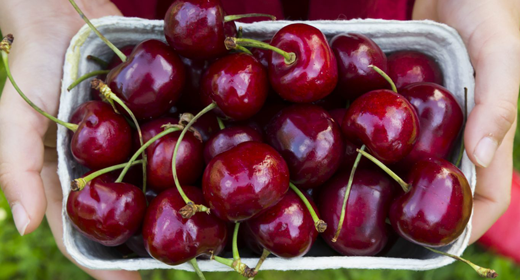
perhaps the most remarkable fruit art of all time. Its anonymous creator carved 113 distinct human heads into a single cherry pit. This is a pretty amazing feat if you think about the size of a cherry pit, (not amazing enough for Christoph von Loß, apparently, who gifted the many-headed cherry to Elector Christian I of Saxony in 1589 and called it “Cherry Stone with 185 Carved Faces,” perhaps figuring that the ruler would be too busy to count them all).
We are proud to announce a new partnership with John and Ocean Robbins and the Food Revolution to bring our readers Summits, Seminars and Masterclasses on health, nutrition and Earth-Conscious living
Sign up today for Plant Powered and Thriving
Which is just to say that of all the fruits in the world, perhaps the cherry turns the most heads.
Cherries are well-loved for their small size, bright color, intense flavor, and sweet or tart taste. They occupy a prominent place in our culture, symbolizing pleasure both gustatory and romantic. Technically, cherries are stone fruits or drupes, not berries, which means they have an outer flesh that surrounds a single inner pit. And botanically, they’re part of the genus Prunus in the rose family and are related to the apricot, peach, plum, and almond.
Cherries often signal the start of summer, at least in the United States. They’re typically available and in season in parts of the Northern Hemisphere between May and August, or between November and February in the southern hemisphere. And many people love cherries! When we say “life is a bowl of cherries,” we mean that life is full of pleasure and enjoyment.
Part of their popularity stems (ooh, a pun!) from their versatility. You can eat cherries raw or cooked, and they go well in both savory and sweet dishes.
Like other brightly colored fruits and vegetables, cherries are full of antioxidants and have a number of health benefits. But what are the different types of cherries, what are the top benefits of cherries, and are there any risks or things to look out for when buying cherries?
Sweet vs Sour Cherries
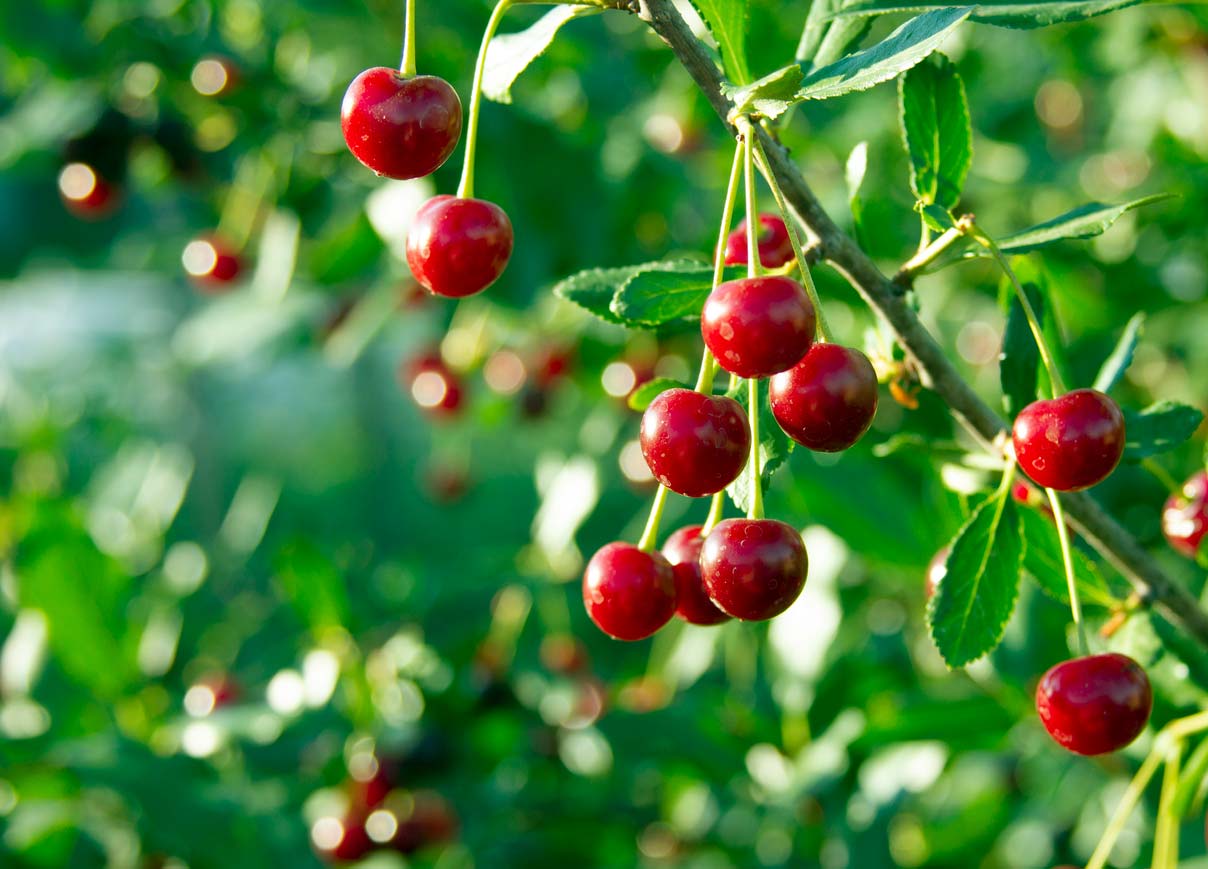
There are two main types of cherries: tart (or sour) and sweet. You can probably guess that one of the most obvious differences between these two is their flavor. This comes from their differing levels of acidity and natural sugar content.
But the differences between tart and sweet cherries go deeper than their flavor profiles. Sweet cherries tend to have a darker pigmentation, and can be almost purple or black, while tart cherries often retain their bright red color from harvest. Most of the fresh cherries you can buy are sweet varieties, as tart cherries are more often processed and used to make tart cherry juice, dried cherries, or sold frozen. As such, fresh sweet cherries are generally available during the summer (unless you eat them canned or frozen), while you can find tart cherry products all year round.
Some research has even found that while all cherries are rich in antioxidants, tart cherries seem to have the most. Other studies give the edge to the sweet cherries. Luckily, you can’t go wrong whichever type you choose to consume: all types of cherries offer an abundance of nutrients that can benefit your health.
Types of Cherries
There are more than 1,000 cherry varieties grown around the world. While the varieties of cherries can differ in their size, color, and best uses, the main differences remain in their sweetness versus tartness. Some of the most popular types of sweet cherries include Bing, Rainier, Tulare, Lambert, Coral, Royal Ann, Chelan, Sweetheart, Utah Giant, Van, Stella, and Skeena. These range in color from yellow to bright red, and are the perfect sweetness to eat on their own or prepared in a variety of ways.
The most prominent varieties of tart cherries include Montmorency and Morello. Both are known for being incredibly tart, so much so that they’re generally difficult to eat on their own and are much more often used to make jam, tarts, or heavily sweetened cherry pie.
Nutritional Profile of Cherries

Cherries are incredibly nutritious, no matter which type you choose to eat. Sour cherries and sweet cherries are similar in their overall nutritional profiles.
One cup (154 grams) of raw, pitted sweet red cherries offers the following:
- Calories: 97
- Protein: 1.6 grams
- Fat: 0.3 grams
- Total Carbs: 24.7 grams
- Fiber: 3.2 grams
- Sugar: 19.7 grams
- Vitamin A: 2% of the Daily Value (DV)
- Vitamin C: 18% of the DV
- Vitamin K: 4% of the DV
- Vitamin B6: 4% of the DV
- Potassium: 10% of the DV
- Copper: 5% of the DV
- Manganese: 5% of the DV
- Magnesium: 4% of the DV
And one cup (155 grams) of raw, pitted tart red cherries offers the following:
- Calories: 77
- Protein: 1.6 grams
- Fat: 0.5 grams
- Total Carbs: 18.9 grams
- Fiber: 2.5 grams
- Sugar: 13.2 grams
- Vitamin A: 40% of the DV
- Vitamin C: 26% of the DV
- Vitamin K: 4% of the DV
- Vitamin B6: 3% of the DV
- Potassium: 8% of the DV
- Copper: 8% of the DV
- Manganese: 9% of the DV
- Magnesium: 3% of the DV
Both categories of cherries are great sources of fiber, potassium, and vitamin C. They each contain an array of other micronutrients, but sour cherries are especially high in vitamin A.
5 Benefits of Cherries
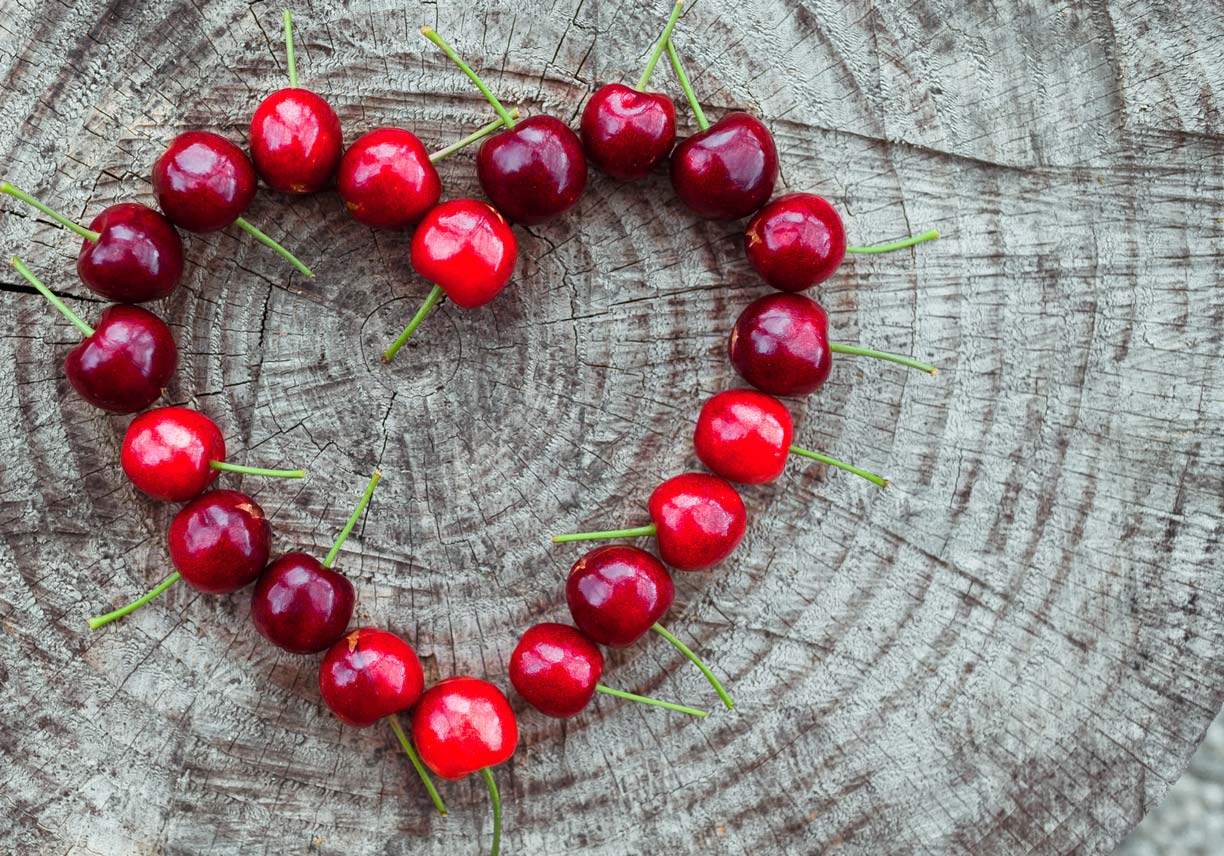
The impressive nutrition of cherries has led to research on their usage for a number of health conditions. So what are cherries good for, besides making us happy when we eat them? Here’s a summary of some of the research on the benefits of cherries for health (and no, I’m not — wait for it — cherry-picking).
1. May Help Treat Inflammatory Arthritis Gout
Sweet cherries may reduce inflammatory markers when eaten consistently and as a regular part of the diet, which could benefit conditions like arthritis gout. In one study, healthy men and women ate 45 cherries a day for a month (that sounds like a fun month to me!) and experienced a 25% reduction in C-reactive protein (a marker for inflammation).
When a similar intervention was performed among adults with gout, eating around 16 cherries a day resulted in lower uric acid levels and a 35% lower risk of gout attacks. And to make sure it wasn’t just an effect of antioxidants like vitamin C, grapes, strawberries, and kiwi fruit were also studied, but found to have no such effect on uric acid levels. In fact, the efficacy of cherries is so convincing that adding them to traditional gout interventions, like a low-purine diet and medications, seems worth a try.
2. Supports Heart Health
Cherries are especially high in antioxidant compounds called flavonoids, which may improve markers of cardiovascular health. Flavonoids can help prevent and endothelial dysfunction, which can lead to atherosclerosis and heart disease. Researchers found that 12 weeks of drinking two daily cups of tart cherry juice resulted in lower systolic blood pressure and LDL “bad” cholesterol levels in adults, as well as improved blood biomarkers of inflammation and oxidative stress (particularly related to heart health).
3. May Improve Your Sleep
Some research has found that eating cherries has a high success rate in reported sleep improvement, (there’s no mention if they led to sweet dreams, however). Melatonin, an antioxidant compound that promotes melanin formation and sleep, is found in both sweet cherries and tart cherries. Several studies have observed the ability of cherry consumption to improve both the quality and quantity of sleephours. Tart cherry juice may even help reduce the severity of insomnia.
4. May Improve Exercise Recovery
Many runners, swimmers, and triathletes drink cherry juice before and after training and races, and some joke that it feels like they’re “doping” because the stuff is so powerful. For instance, in a 2020 studypublished in the Scandinavian Journal of Medicine & Science in Sports, researchers found that tart cherry juice improved recovery of muscle function after running a marathon by increasing antioxidant activity and reducing inflammation, as compared to placebo. (I do have to wonder how the researchers made a placebo version of tart cherry juice. It seems like it would be hard to keep the runners from knowing what they were drinking. But apparently, the researchers figured out a way, proving once again that science is amazing!).
Tart cherry juice also has research to support improving recovery of isometric muscle strength after intensive exercise by preventing oxidative damage. And in a 2016 study, endurance athletes who consumed 480 mg of tart cherry capsules once daily for 10 days experienced less muscle breakdown and immune and inflammatory stress, as well as better aerobic performance, compared to the placebo group.
5. Promotes Healthy Glucose Regulation
Cherries may also offer benefits for blood sugar control. For example, one study found that women with diabetes who consumed 40 mL per day of concentrated tart cherry juice for 6 weeks experienced a significant reduction in HgA1c, an indicator of long-term blood sugar control. Extracts from both sweet and tart cherries were able to prevent drug-induced diabetes among rats and mice in animal studies. This is likely related to the many antioxidant compounds in cherries, such as chlorogenic acid, anthocyanins, hydroxycinnamic acid, and flavanols, which may work mechanistically to prevent blood sugar spikes and improve regulation.
What About Maraschino Cherries?
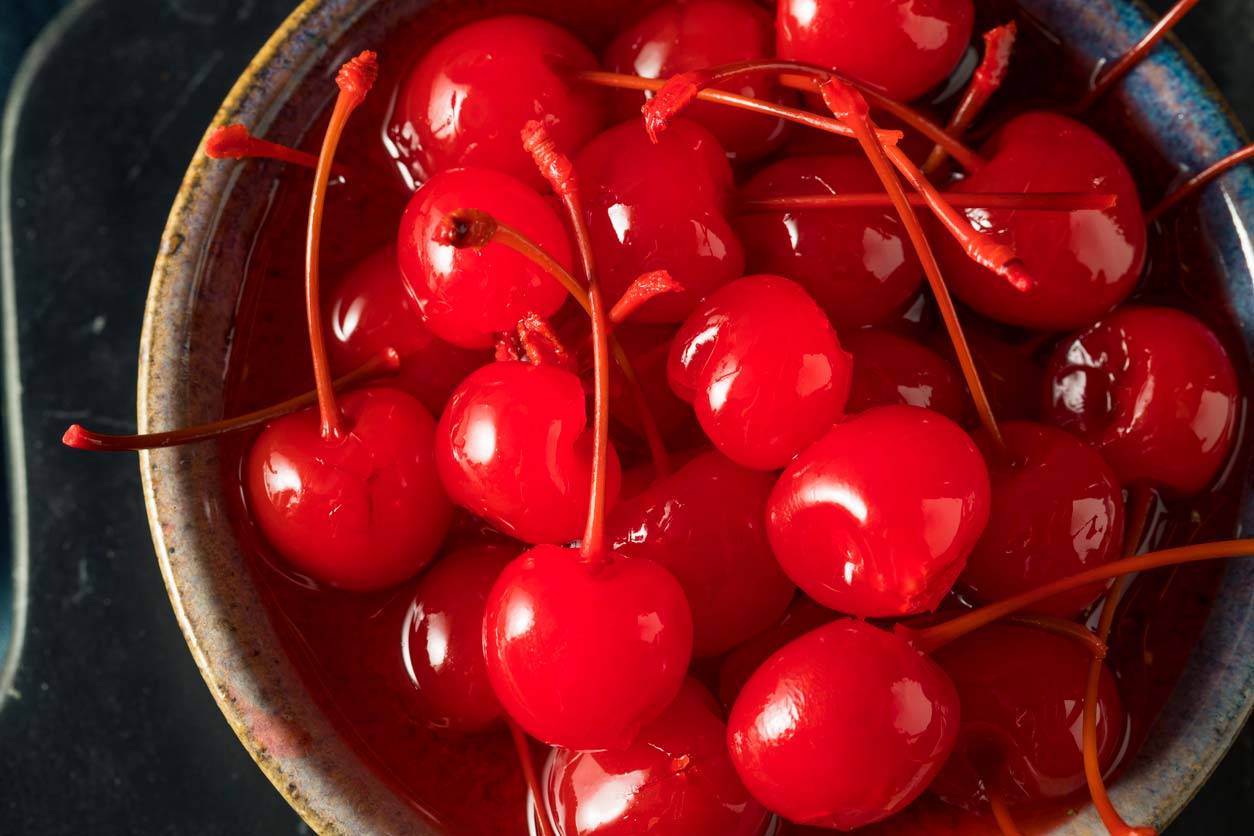
All this talk about cherries may have you wondering about those oddly neon-colored varieties typically seen on top of desserts or on the rims of cocktails. These are called maraschino cherries.
Maraschinos are bright red, sweet cherries that are highly processed. In other words, these are not a variety of cherry on their own. In the past, they were preserved in a liqueur made from the Marasca cherry. These days, preservation involves using artificial preservatives and flavors. They’re colored with artificial colorings and typically bathed in high fructose corn syrup to reach their over-the-top sweetness.
That all makes sense for the red Maraschino cherries. But what about the blue and green ones? Regular sweet cherries (often the Royal Ann sweet cherry) go through a bleaching process to make them so white in order to dye them any color desired.
Maraschino cherries are not a health food, and really shouldn’t be considered a food at all given the degree of processing they have to go through to create the end result.
Risks of Eating Cherries
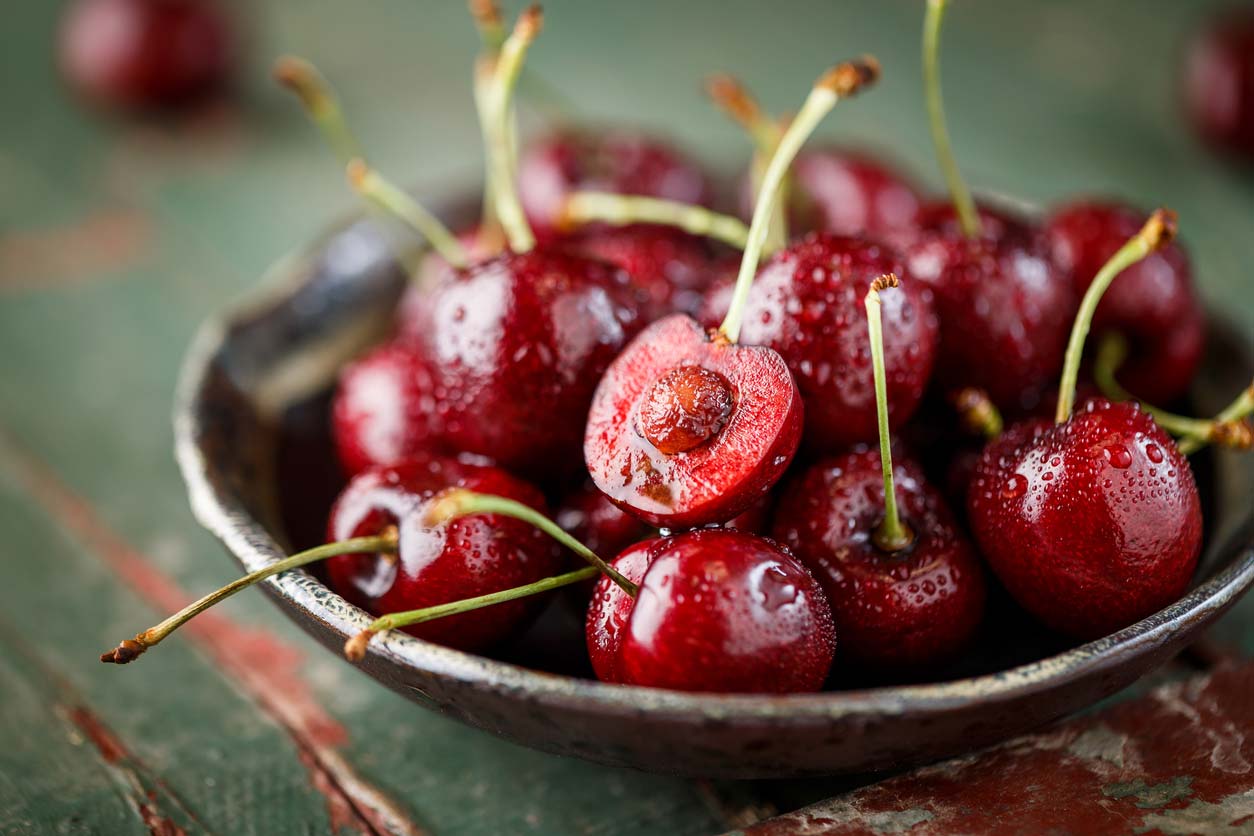
Cherries offer a long list of health benefits, making them an excellent addition to most diets. However, there may be a few things to keep in mind when incorporating cherries into your regular diet.
Cherry Pits
First, because cherries are stone fruits, they each contain a single pit in their middle, which can be potentially harmful should humans eat them.
The problematic chemical in cherry pits is called amygdalin. When you ingest amygdalin, particularly when the pit is crushed or chewed, your body converts it into cyanide. Cyanide is one of the deadliest poisons known to us. But don’t worry — while it’s definitely not recommended to grind up cherry pits in your smoothie, or swallow handfuls of them whole, Poison Control says that small ingestions (like a sneaky cherry pit) generally don’t cause any harm.
Accidental ingestion of poisonous compounds isn’t the only risk when it comes to cherry pits. The pits in and of themselves are a choking hazard, especially for children. It’s a good idea to remove cherry pits before offering them to young kids, and teach kids to spit out the pits when they’re old enough to eat them on their own.
High in Sugar
You may have noticed from the nutritional compositions listed above that cherries are naturally high in sugars. To give you a frame of reference, one cup of fresh raspberries contains around seven grams of sugar, whereas the same serving of cherries has 13-20 grams, depending on the variety.
It’s important to note that natural sugars found in fruits and vegetables come in tandem with healthy nutrients like fiber, antioxidants, phytochemicals, vitamins, and minerals. This is vastly different from the highly processed and refined sugar that you might find in a packaged cookie.
Glycemic Load
Still, such a concentrated amount of natural sugar could impact some people. For instance, individuals who need to monitor their blood sugar should be aware of how cherries may impact their glucose levels. Despite their sweetness, cherries have a surprisingly low glycemic index (GI). The GI of fresh sweet cherries is 62, which is actually lower than the GI of brown rice (which comes in at 68), and on par with the GI of a boiled sweet potato (also 62). The GI of fresh sour cherries, by comparison, is just 22, which actually makes them a low-impact food when it comes to blood sugar according to the Glycemic Index Chart.
And what about Glycemic Load, which many researchers consider an equally important indicator of the true blood sugar impact of food? Both sweet and sour cherries come in at just 9, which makes them low glycemic load foods.
If you have diabetes, and you’re uncertain how cherries may impact your blood sugar, it may be best to enjoy them in smaller, more controlled portions and monitor what happens. Furthermore, choose fresh cherries over dried, as the latter will contain much more concentrated amounts of sugar.
Still, studies show that despite their sugar content, cherries may offer some benefits for people with diabetes. For instance, some research shows that cherry polyphenols and vitamin C can reduce inflammation and oxidative stress that can worsen diabetic control, as well as compounds called anthocyanins that may improve insulin sensitivity.
GI Issues
The high natural sugar content of cherries, along with sugar alcohols, and compounds called salicylates can cause digestive problems for some people.
If you find that cherries have this effect on you, it’s probably best not to eat too many all at once. Sticking to a smaller serving size, like a ½-cup at a time, may be a good approach. I found this out the hard way recently when I ate a pound of cherries at a single sitting. My tummy felt a little uncomfortable for the next few hours, which was a pretty good indication that I had overdone it. But the cherries tasted so good that I concluded it was a worthwhile price to pay.
Pesticides
Cherries are on the Environmental Working Group’s (EWG) annual Dirty Dozen list. This means that they are among the top 12 most pesticide-laden crops when purchased conventionally grown, or non-organic. In fact, according to the EWG, more than 90% of the cherry samples they tested contained residues from at least two pesticides.
The USDA has also conducted testing on cherries, finding that nearly half of the samples contained residues of a neurotoxin called bifenthrin, which paralyzes and kills insects.
Imported cherries may come with their own issues, based on suspicions of loopholes in the oversight of organic standards from countries of origin like China and Turkey. Your best best is probably homegrown or local, organic cherries, either fresh or frozen. Fresh organic cherries can be harder to find, so if you do choose to eat non-organic fresh cherries, be sure to wash them well (by soaking them in a baking soda solution for 10 minutes and then rinsing them) before consuming.
How to Choose and Store Cherries
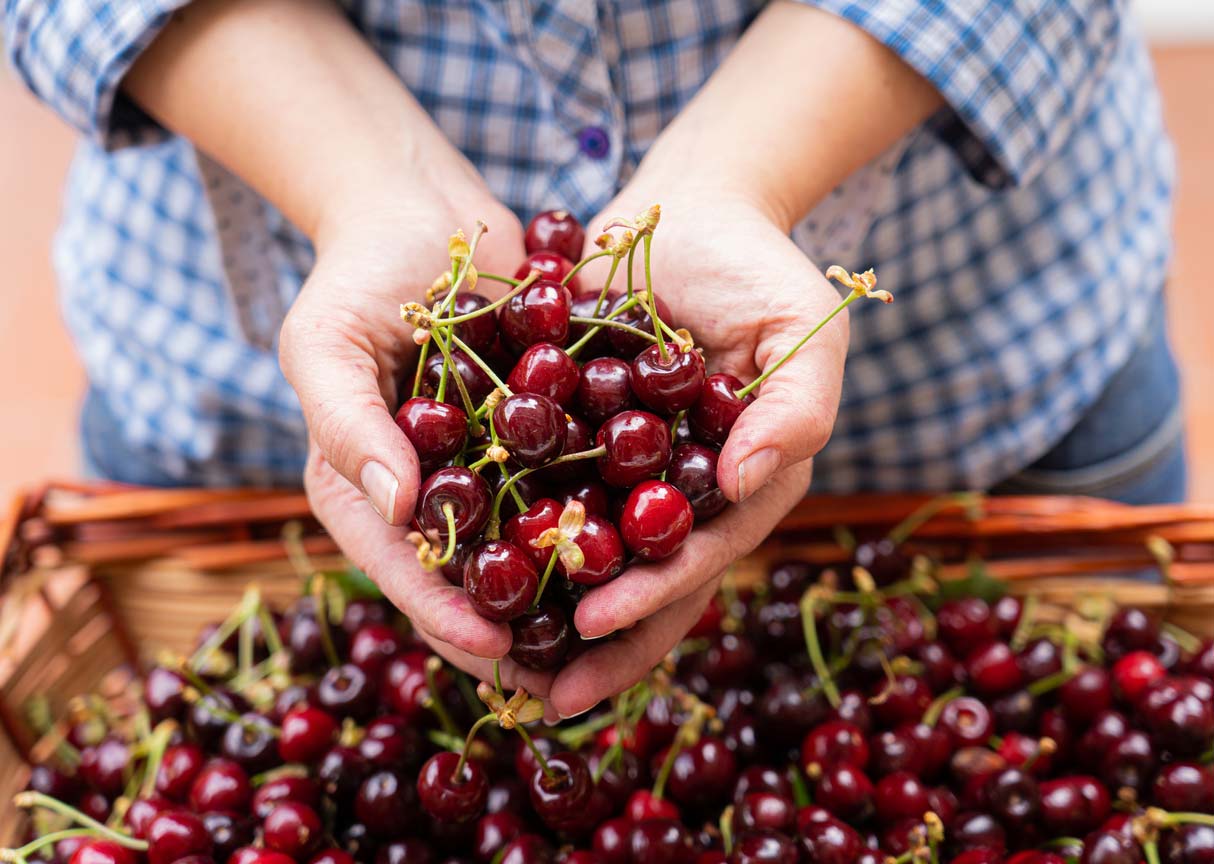
As with any fresh produce, it’s important to know what to look for at the grocery store or market when choosing cherries. Here are some tips for choosing the best cherries to optimize freshness, flavor, and shelf life:
- Choose cherries that are plump and firm.
- Choose cherries that are bright in color, but keep in mind that Bing and other purple cherry varieties have a darker appearance when ripe.
- Avoid cherries with visible bruising or soft spots, as this can indicate rotting underneath the surface.
When you get your cherries home, store them in your refrigerator. Don’t wash your cherries until you’re ready to eat them, as this can cause spoilage and premature degradation. Fresh cherries should generally be eaten within 5-7 days of purchasing (less if they are very ripe), but if you don’t think you’ll get to them by then, you can always freeze them for longer preservation. (Pro tip: Remove the pits before you freeze cherries. Frozen and pitted cherries can make a great treat!).
How to Use Cherries

Like other fresh fruits, you can enjoy cherries in their most natural form — just make sure to spit out the pit!
Of course, you can also incorporate cherries into a number of dishes. They work well in both sweet and savory dishes and offer unique flavors to both cold and warm recipes. Sweet cherries are generally used in desserts and sweeter dishes, whereas sour cherries are more often used in savory recipes, although tart cherry pie can be delicious, too!
Here are some ideas for using, and reaping the benefits of, sweet or tart cherries:
- Eat them straight away (personally, this is my favorite option of all)
- Use them to make cherry preserves, jam, or jelly
- Chop them into sweet or tart chutneys and salsas
- Slice them in half and mix them into a fresh fruit salad
- Chop or slice them thinly and use them to top a leafy green salad
- Use them in a variety of plant-based desserts, like pies, cakes, and cobblers
- Use them to make cherry vanilla n’ice cream, by blending frozen cherries, frozen bananas, soy or nut milk, and vanilla (yum!)
- Blend them into smoothies or homemade juices
- Blend them into homemade salad dressings and other sauces or marinades
- Use them to top plant-based yogurt, granola, or oatmeal bowls
Recipes With a Cherry on Top!
Cherries are a fun snack to enjoy on their own, especially when they’re fresh and in season. However, you can enjoy them year-round when you purchase them frozen (and, sometimes, frozen has even more nutritional value since they’re harvested at the peak of ripeness and frozen immediately!).
Start the day with antioxidant-packed cherries with the Toasted Pistachio and Cherry Overnight Oats. The refreshing and crunchy Cherry Waldorf Salad will appeal to fans of traditional Waldorf Salad, as well as those who are unfamiliar with the dish (give it a try!). Finally, Cherry Vanilla Crepes deserve their own category — heaven! They’re ridiculously delicious.
1. Toasted Pistachio and Cherry Overnight Oats
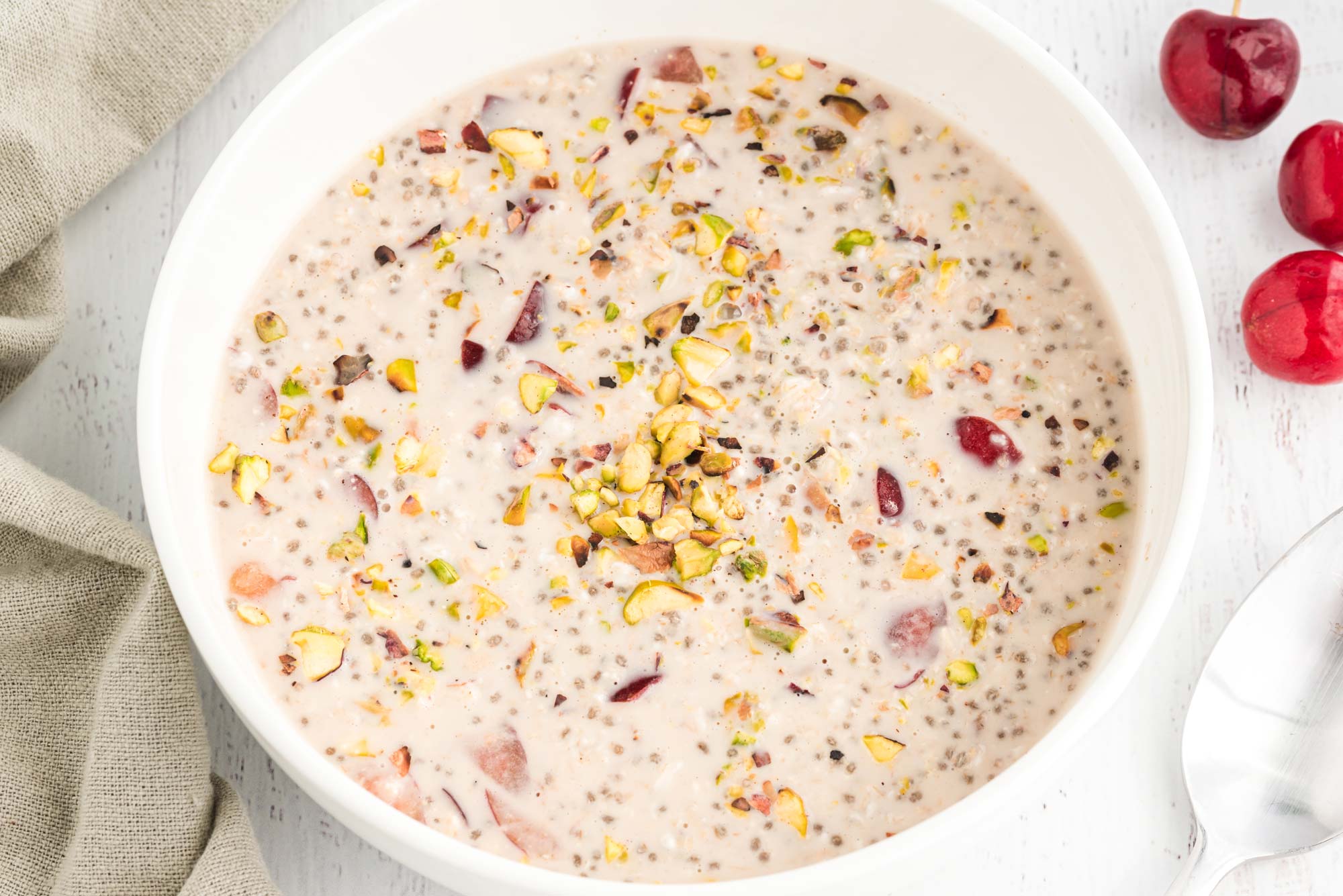
Nothing beats waking up in the morning knowing that your breakfast is waiting for you. Cherries and pistachios are like a culinary match made in heaven, giving traditional oatmeal a flavor and texture lift. Not to mention, cherries and pistachios are packed with nutrients to fight inflammation from their abundant phytonutrients. Use frozen cherries to enjoy this breakfast treat all year round!
2. Cherry Waldorf Salad
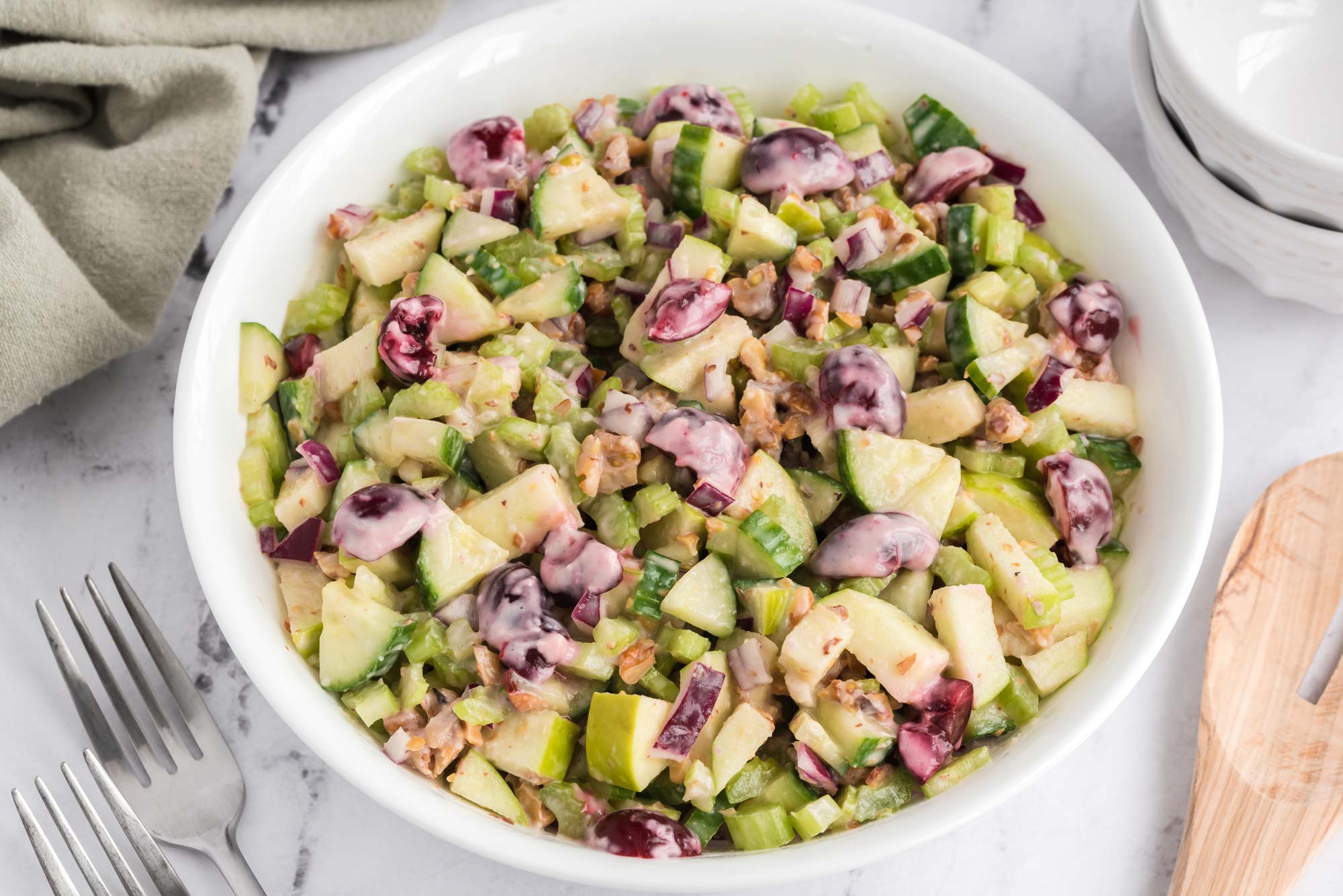
If you’re a fan of traditional Waldorf Salad then we bet you’ll love this version even more. If not, we’re feeling pretty confident that we can convert you. Tart cherries with toasted walnuts and a creamy, plant-based yogurt dressing come together to make an incredible snack or side dish to your main meal. Plus, it’s packed with phytonutrients in the cherries, omega-3s in the walnuts, and probiotics in the dressing.
3. Cherry Vanilla Crepes

Whoa. Whoever thought of the combination of vanilla and cherries, thank you. We love you forever. Slightly sweet and tart cherries combined with vanilla cashew cream stuffed inside a buckwheat crepe might be the definition of heaven. The fact that this treat is also good-for-you is simply mind-blowing!
Sweet, Sour, and Good For You

Cherries are not only pleasing to the eye, they can also be pleasing for your health. And the cherry on top (bet you didn’t see that pun coming!) has got to be their deliciousness. There are many varieties of sweet and sour cherries, all with a number of remarkable health benefits. Although there are a few things to look out for with cherries, including their high sugar content and the potential for pesticide contamination, with an awareness of these issues, cherries can be, for most people, an excellent addition to a healthy, whole foods diet — with many ways to prepare and eat them.
Tell us in the comments:
- Are you a fan of cherries? Do you prefer tart or sweet cherries?
- What are some of your favorite ways to incorporate cherries into your diet?
- Do you live in an area where you can go cherry-picking and enjoy them right off of the trees?









































